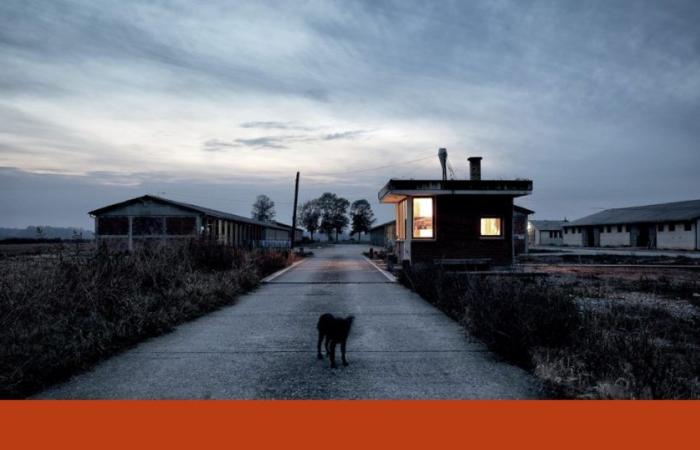On the outside, there are only buildings in Bosnia and Herzegovina: schools, sports halls, industrial or administrative buildings, hotels, factories, museums, mosques, housing. But if its walls could talk, they would tell stories of the systematic rapes of women that occurred during the war that followed the dismantling of Yugoslavia, between 1992 and 1995, which the UN estimates to be around 20 thousand.
“How is it possible to relax inside a hotel where systematic violations have been committed?” asks German photographer Cornelia Suhan in the pages of the photobook she signs, entitled Silent Witness, published by Gost Books, in March. “What about the children who study in the classrooms where their grandmothers may have been raped? How is it possible?”
The German woman, who specializes in architectural photography, has a long-standing relationship with Bosnia and Herzgovina and is related to the establishment of a therapy center for women victims of rape in Tuzla, in the east of the country. “I have been visiting Bosnia year after year since 1993,” she writes in the afterword. He only failed in the year of his daughter’s birth, 1995, which was marked by the Sbrenica genocide.
For many years, until 2018, the year she began the photographic project, Cornelia Suhan would pass by buildings where crimes had been committed and think about what had happened inside. “They are scattered throughout Bosnian territory in innocuous places,” she writes. “Often abandoned, the buildings are simply there, without any indication of the crimes that took place inside. The dead walls of the houses seemed to stare at me.”
Through her organization, but not exclusively, Cornelia came into contact with many of the rape victims who shared their testimony in the book. “To this day, despite the numerous rape trials that have taken place in the country, many women have not received justice because the perpetrators are acquitted or trial records are obstructed.” She also says that, in the country, the issue of sexual violence in the context of war is still “a pawn in ethnically based ideological battles”. “There is barely room for pause, for mourning, for understanding and honoring the victims.”
Among women, the silence is breaking. One of the factors that contributed to this is the granting of pensions by the Bosnian government, since 2006, to war victims – including women victims of rape. Silent Witness contains dozens of accounts from women who were victims of rape juxtaposed with photographs of the places where the crime they suffered was perpetrated. The sometimes extreme violence of the memories narrated in the first person by the women contrasts brutally with the silence and innocuousness of the images – and it is in this contrast that the communicative power of this book lies.
The reports are intense and often include detailed descriptions of the context in which the violations occurred. This context is permeated with violent death, terror and inclemency on the part of soldiers from the various factions in the conflict. The victims, sometimes Bosniaks, sometimes Croats or Serbs, suffered similar crimes at the hands of each other. Cornelia’s objective was to remove any ideology or benefit any ethnicity from the equation.
Fikreta, a native of Bosnia and Herzgovina’s third largest city, Tuzla, peers through the window of a dilapidated house. In his company are his mother and two other women who observe the interior of the building. After witnessing the murder of his father in a nearby village, it was in that house that, at just 15 years old, Fikreta was the victim of rape by a Serbian soldier. “I still have nightmares today,” the woman told the German photographer. “When I sleep, it feels like I’m falling. They chase me, they run after me, and I run, run, but I can’t escape. And I start screaming in my sleep.”
In 1992, at the beginning of the war, Emina, from Mramor (Tuzla), was taken with her family by Serbian soldiers to a concentration camp near Zvornik, in Republika Srpska. Inside a building where an embroidery business operated, Emina was raped three times “by people she didn’t know”. “In addition to the rape, I witnessed torture and attacks by third parties. My sister and I were forced to throw a dismembered body into the Drina River.”
Inside the Bradina primary school, in the municipality of Konjic, women, children and elderly people who survived the Bradina massacre had their jewelry and valuables confiscated. Girls and women were raped. In July 1992, soldiers raped 15 women. Around 15 male prisoners were also raped by soldiers.
“A war does not end when the guns fall silent,” writes Cornelia. In the minds of those who have suffered or witnessed the violence of war, weapons continue to resonate, to tear, to hurt. “I learned in Bosnia to adapt to the slow process of making these crimes visible. To this day, women are also slow to enter public discourse.” Some of the women Cornelia photographed told their stories in front of other cameras, hoping to be seen and the crime of which they were the target recognized. “They also spoke on behalf of all those who chose to remain silent. All of them, despite the countless projects that exist to support them, live their pain alone. It was his loneliness, his invisibility and his courage that led me to photograph.”
Tags: Architecture silence Bosnian buildings hold stories rape Photogallery
--





